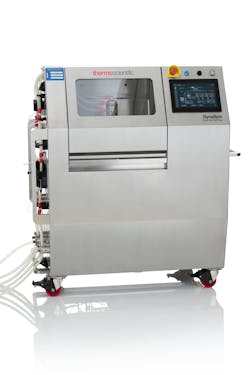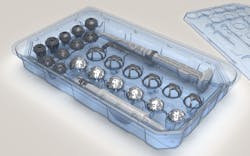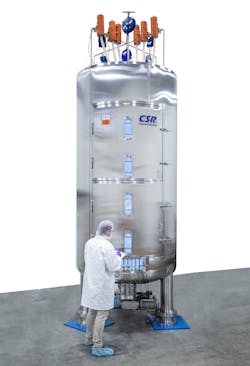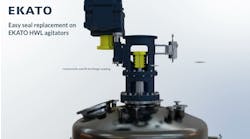Single Use Technology Growth Poised to Continue in 2023
Single use technologies (SUTs) boast a range of process benefits, including ease of cleaning, reduced risk of contamination, flexibility and speed in bioprocess development, and improved sustainability through reduced water, chemicals and energy use.
Coupled with lower capital cost, reduced time to facility qualification and improved time-to-market of the final product, the demand on SUT vendors, such Thermo Fisher Scientific, Cytiva, Solvay and ABEC, was high even before the Covid-19 pandemic took hold.
“This demand increased significantly once the virus spread globally, and numerous companies and countries urgently sought treatments and preventions,” says Mark Smith, senior manager of research and development, Thermo Fisher Scientific, Logan, Utah. “The need for speed and flexibility in bioprocess development and production – which SUTs provide – became paramount.”
To meet increased demand for SUTs, Thermo Fisher has invested more than $650 million since 2021 to expand its bioproduction capabilities, including the development of purification and recovery SUTs that can lead to significant yield improvements, Smith says. The company also has developed digital solutions that help optimize SUTs by transforming data into meaningful insights.
Smith points to the latest release from Thermo Scientific, its new Ramina process analyzer, which uses Raman spectroscopy, as an example of how digital technologies can help measure samples of critical analytes, such as glucose, lactate, viable cell density, in single-use bioprocesses.
Sustainable SUTs Take Hold
Then, there are the ongoing developments in materials and material science used in SUTs. Here, Smith cites two examples of how different applications demand different features.
First, is the demand from customers for highly recyclable materials, such as single-layer films, that exhibit similar performance as the multi-polymer materials used today.
“High recyclability could alternatively include development of novel methods for recycling complex materials, such as multilayer films back to functionally virgin monomer – beyond basic regrind,” he notes. “Then, there are emerging bioprocess technologies that have uniquely demanding materials requirements not typically met by current materials today.”For example, cell therapies can be extremely sensitive to materials like leachables and must aim for particulate-free containers because such contaminants cannot be filtered away. As another example, nucleic acid therapies, such as those based on mRNA, can also require use of organic solvents, which are damaging to traditional materials.
In addition to recyclable material, Thermo Fisher is building sustainability into some of its product designs. Two examples are the DynaDrive single-use (SU) bioreactor and DynaSpin SU centrifuge, which require fewer filters for harvesting and less cleanroom space for production, according to Smith.
Industry 4.0 Optimizes SU Processes
Global life sciences company Cytiva, which provides technologies for a wide range of therapeutics, including mRNA vaccine production, is another company that has seen increased demand for its SUTs since the Covid-19 pandemic began. In fact, SUTs may have helped manufacturers ramp up production of mRNA vaccines and monoclonal (mAb) antibody treatments during the pandemic, says Jon Van Pelt, general manager, bioprocess single use and enterprise solutions, Cytiva, Marlborough.
“The application of SU equipment from benchtop to full cGMP production enabled rapid scale up in areas like mRNA vaccines and mAb therapeutics,” he says. … The pandemic only further highlighted the operating flexibility and efficiency of SU technologies, particularly in terms of a more sustainable operating environment due to less water, chemical, and energy consumption.”
Like Thermo Fisher, Cytiva is expanding the availability of Industry 4.0 offerings, which can speed up “the process development cycle through advanced data capture and analytics and reduce batch-to-batch variation,” Van Pelt says.
Van Pelt points to the emergence of more robust SU sensors to monitor common parameters including pH, dissolved oxygen, viable cell density and flow – having overcome post-gamma irradiation shelf-life issues, measurement drift and issues with fiber optic and wireless connections to transmitters.
“The focus has shifted to development of cost-effective single-use sensors for more complex measurement such as glucose, lactate concentrations and inline protein concentration,” he explains.
Van Pelt points out that the flexibility of SU equipment allows for faster scale up and application design, whether in a lab or cGMP environment.
Novel Circularity Plan
The biopharmaceutical industry’s push to rapidly integrate SU assets makes it the technology of choice for over 50% of the world’s Covid-19 vaccine production, according to Belgian chemicals group Solvay.
In response, the company is boosting development its portfolio SU polymers based on polyether ether ketone, polysulfone, polyphenylsulfone, polyethersulfone and polyarylamide (PARA). Each exhibits a range of different qualities for bioprocessing such as chemical resistance, heat resistance, gamma stability, hydrolytic stability and impact resistance.
However, bioprocessing components made of premium, medical-grade, high-performance polymers can cause circularity issues, not least because they require cleaning and sterilizing at an early stage. Another issue is that for regulatory reasons they cannot be recycled into materials that will be reused in patient applications, or which come into contact with food products.In November 2021, Solvay signed an agreement with a French start-up called Ostium Group, which makes SU surgical instruments. This project was designed to enable the mechanical recycling of end-of-life SU surgical instruments molded in Solvay’s glass-fiber reinforced Ixef PARA. Typically, such instruments are incinerated today.
The plan is to collect, disinfect and mechanically recycle used Ixef PARA surgical instruments. The reground PARA compound will then be upcycled with additional – unspecified – processing steps into other applications.
The company would not disclose the processing steps but said that “after disinfection, cleaning, mechanical recycling, and recycled product characterization, our research and innovation teams are evaluating the use of recycled material to develop new high-performance compounds suitable for various markets, such as automotive and sports equipment.” (Figure 2).
Initial trials have shown that the recycled PARA compound provides a very high level of performance, with up to 85% of flexural properties and no loss in surface appearance when compared with the virgin grade – with the additional advantage of a lower carbon footprint, according to Solvay.
ABEC Expands SUT Offerings
In late August last year, ABEC, a provider of SU process solutions, announced an $11 million investment to increase manufacturing capacity at its plant in Wilson, North Carolina. The plan is to expand the production of SU disposable containers (DCs) used with its custom single run (CSR) biomanufacturing technologies, making it the company’s third global DC manufacturing site. The other two are in Fermoy, Ireland, and at ABEC’s Bethlehem, Pennsylvania, headquarters. Full production at Wilson is expected to begin in the second quarter of this year.There are three main drivers behind the latest developments in SU processing, according to Brady Cole, ABEC vice president of equipment solutions. First, is the broad adoption of large-scale SU systems because of their ability to reduce costs for cell culture and microbial fermentation. This includes an increase in demand for bioreactors up to 6,000 liters versus the traditional 2,000-liter scale and microbial fermenters up to 1,000 liters, Cole notes.
The company also is seeing increased adoption of hybrid single use/stainless steel approaches for new manufacturing facilities, which, says, Cole, can provide the best overall solution when considering cost, flexibility, and productivity.
“Finally, we are seeing higher and higher cell density requirements for mammalian cultures in order to enable process intensification, and our CSR single use bioreactors are successfully achieving these high densities,” he added.






